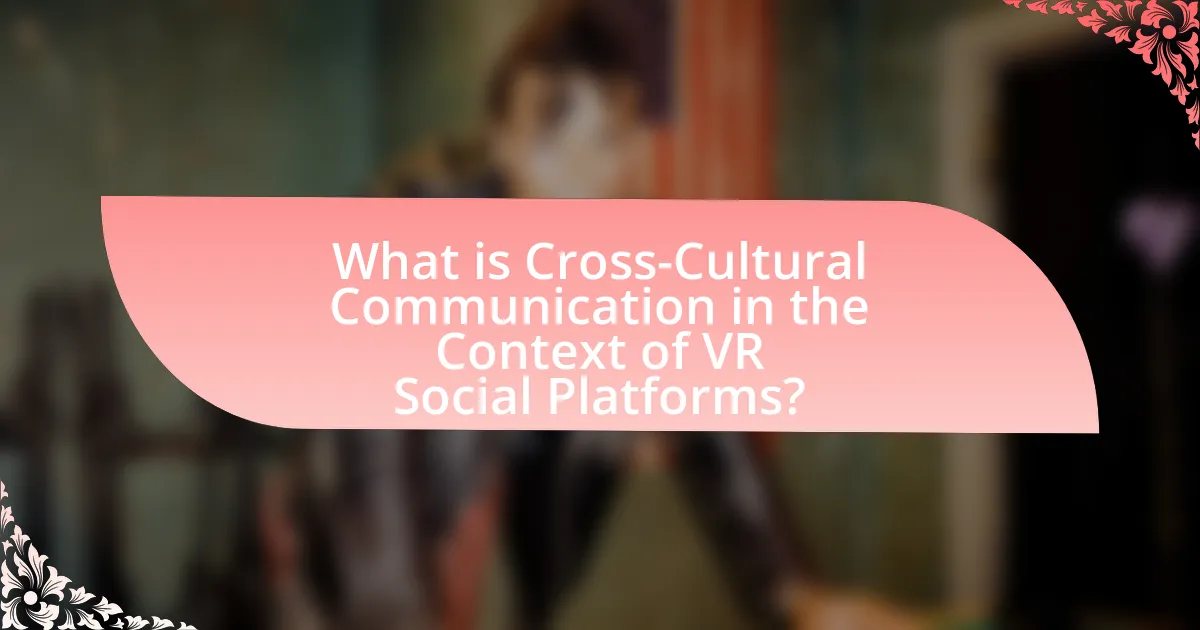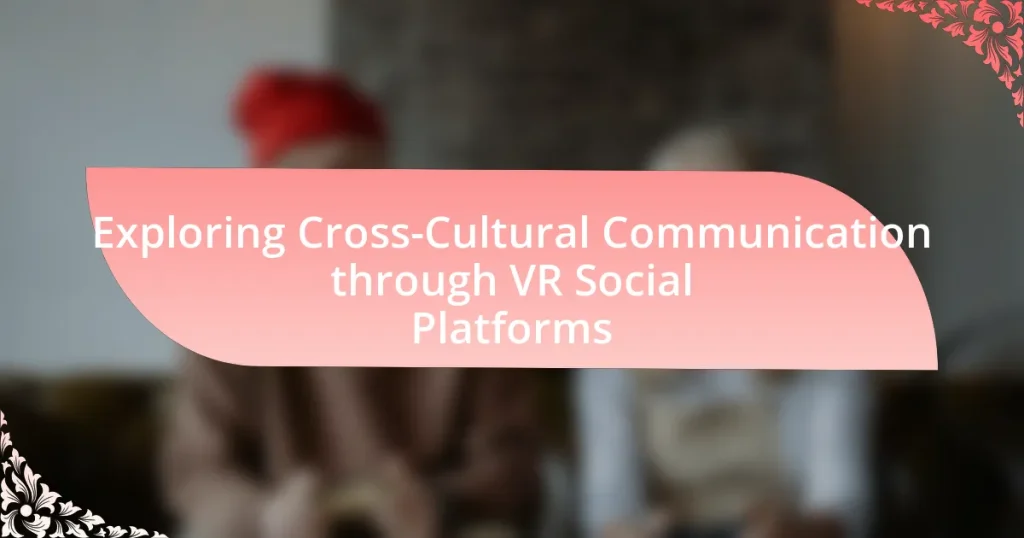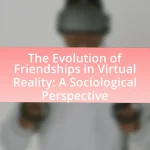Cross-cultural communication in the context of VR social platforms involves the interaction between individuals from diverse cultural backgrounds within immersive virtual environments. This article explores how VR technology enhances communication by creating real-time, shared experiences that foster empathy and understanding. Key features of VR platforms, such as immersive environments and non-verbal cues, significantly improve user engagement and cultural awareness. The article also addresses challenges in cross-cultural interactions, including language barriers and differing social norms, while highlighting strategies and tools that can enhance effective communication in VR settings. Additionally, it discusses future trends in VR technology that may further shape cross-cultural communication.

What is Cross-Cultural Communication in the Context of VR Social Platforms?
Cross-cultural communication in the context of VR social platforms refers to the interaction and exchange of information between individuals from diverse cultural backgrounds within virtual environments. This form of communication is facilitated by immersive technologies that allow users to engage in real-time conversations, share experiences, and collaborate across geographical boundaries. Research indicates that VR social platforms can enhance empathy and understanding among users by providing realistic simulations of different cultural contexts, thereby promoting more effective communication. For instance, studies have shown that participants in VR environments report increased cultural awareness and sensitivity, which are crucial for successful cross-cultural interactions.
How does VR technology facilitate cross-cultural communication?
VR technology facilitates cross-cultural communication by creating immersive environments where users can interact in real-time, regardless of geographical barriers. This technology allows individuals from diverse cultural backgrounds to engage in shared experiences, enhancing understanding and empathy. For instance, studies have shown that VR simulations can effectively reduce cultural biases by allowing users to experience life from another person’s perspective, fostering deeper connections. Additionally, platforms like VRChat and AltspaceVR enable users to communicate through avatars, which can represent various cultural identities, further promoting inclusivity and dialogue among different cultures.
What are the key features of VR social platforms that enhance communication?
Key features of VR social platforms that enhance communication include immersive environments, real-time interaction, and non-verbal cues. Immersive environments allow users to engage in shared virtual spaces, fostering a sense of presence and connection. Real-time interaction enables instant communication, facilitating conversations that mimic face-to-face interactions. Non-verbal cues, such as gestures and facial expressions, are captured and conveyed through avatars, enriching the communication experience. Research indicates that these features significantly improve user engagement and understanding, making VR platforms effective for cross-cultural communication.
How do immersive experiences impact cultural understanding?
Immersive experiences significantly enhance cultural understanding by allowing individuals to engage with diverse cultures in a firsthand manner. These experiences, often facilitated through virtual reality (VR) platforms, enable users to interact with cultural artifacts, participate in traditional practices, and communicate with individuals from different backgrounds. Research indicates that immersive environments can lead to increased empathy and reduced prejudice, as participants gain a deeper appreciation for cultural nuances and perspectives. For instance, a study published in the journal “Computers in Human Behavior” by authors Mel Slater and Maria V. Sanchez-Vives found that VR experiences can effectively promote empathy by placing users in the context of another culture, thereby fostering a more profound understanding of cultural differences.
Why is cross-cultural communication important in today’s globalized world?
Cross-cultural communication is crucial in today’s globalized world because it fosters understanding and collaboration among diverse cultures. Effective communication across cultures enhances international business relations, as evidenced by a study from the Harvard Business Review, which found that companies with culturally diverse teams are 35% more likely to outperform their competitors. Additionally, cross-cultural communication reduces misunderstandings and conflicts, promoting social cohesion in multicultural societies. This importance is underscored by the increasing interconnectedness of economies and societies, where miscommunication can lead to significant economic and social repercussions.
What challenges do individuals face in cross-cultural interactions?
Individuals face several challenges in cross-cultural interactions, including language barriers, differing social norms, and varying communication styles. Language barriers can lead to misunderstandings and misinterpretations, as individuals may struggle to convey their thoughts accurately or comprehend others’ messages. Differing social norms can create discomfort or offense, as behaviors considered acceptable in one culture may be viewed negatively in another. Additionally, varying communication styles, such as direct versus indirect communication, can result in confusion and frustration during interactions. These challenges are supported by research indicating that effective cross-cultural communication requires awareness and adaptation to these differences to foster understanding and collaboration.
How can VR social platforms address these challenges?
VR social platforms can address challenges in cross-cultural communication by implementing features that enhance user interaction and understanding. These platforms can utilize real-time translation tools to bridge language barriers, allowing users from different linguistic backgrounds to communicate seamlessly. Additionally, incorporating culturally relevant avatars and environments can foster a sense of belonging and respect for diverse cultures, promoting more meaningful interactions. Research indicates that immersive experiences in VR can significantly improve empathy and cultural awareness, as users engage in shared experiences that reflect various cultural contexts. For instance, a study by the University of Maryland found that VR experiences can enhance empathy by allowing users to “walk in someone else’s shoes,” thereby improving cross-cultural understanding.

What are the Benefits of Using VR Social Platforms for Cross-Cultural Communication?
Using VR social platforms for cross-cultural communication enhances engagement, empathy, and understanding among diverse cultural groups. These platforms create immersive environments that allow users to interact in real-time, breaking down geographical barriers and fostering meaningful connections. Research indicates that immersive experiences can significantly increase empathy levels; for instance, a study published in the journal “Computers in Human Behavior” found that participants who engaged in VR experiences reported higher empathy towards individuals from different backgrounds. Additionally, VR platforms often incorporate cultural elements, enabling users to experience and appreciate different traditions and practices firsthand, which further enriches cross-cultural dialogue.
How do VR platforms promote empathy and cultural awareness?
VR platforms promote empathy and cultural awareness by immersing users in diverse cultural experiences and perspectives. Through virtual environments, users can engage in scenarios that simulate the lives and challenges of individuals from different backgrounds, fostering a deeper understanding of their experiences. Research indicates that immersive experiences in VR can lead to increased empathy; for instance, a study published in the journal “Computers in Human Behavior” found that participants who experienced VR simulations of marginalized communities reported higher levels of empathy towards those groups. This immersive engagement allows users to confront their biases and develop a more nuanced appreciation for cultural differences, ultimately enhancing cross-cultural communication.
What role does avatar representation play in cross-cultural interactions?
Avatar representation plays a crucial role in cross-cultural interactions by influencing how individuals perceive and engage with one another in virtual environments. The design and characteristics of avatars can reflect cultural identities, which helps users navigate social dynamics and establish connections across diverse backgrounds. Research indicates that avatars that align with users’ cultural norms can enhance feelings of presence and empathy, facilitating smoother communication. For instance, a study published in the journal “Computers in Human Behavior” by Bailenson et al. (2008) found that culturally congruent avatars led to more positive interactions among participants from different cultural backgrounds, demonstrating the importance of avatar representation in fostering understanding and collaboration in virtual spaces.
How can shared virtual spaces enhance collaborative learning?
Shared virtual spaces enhance collaborative learning by providing immersive environments that facilitate interaction and engagement among learners. These spaces allow participants from diverse backgrounds to collaborate in real-time, breaking geographical barriers and fostering cross-cultural communication. Research indicates that virtual reality platforms can increase motivation and retention rates by up to 75%, as learners are more likely to engage with content when it is presented in an interactive format. Furthermore, shared virtual spaces enable the use of multimedia resources, which cater to various learning styles and promote deeper understanding through experiential learning.
What are the potential drawbacks of VR in cross-cultural communication?
The potential drawbacks of VR in cross-cultural communication include the risk of misinterpretation of cultural cues and the potential for technological barriers. Misinterpretation occurs because VR environments may not accurately represent cultural nuances, leading to misunderstandings. For instance, gestures or expressions that are acceptable in one culture may be offensive in another, and VR may not convey these subtleties effectively. Additionally, technological barriers such as access to VR equipment and internet connectivity can limit participation from individuals in less developed regions, exacerbating existing inequalities in cross-cultural interactions.
How can technological barriers affect participation?
Technological barriers can significantly limit participation in VR social platforms by restricting access to necessary hardware and software. For instance, individuals without high-performance computers or VR headsets may be unable to engage fully in virtual environments, leading to unequal opportunities for interaction. According to a report by the International Telecommunication Union, approximately 3.7 billion people remain unconnected to the internet, which further exacerbates disparities in participation across different cultural and socioeconomic groups. This lack of access can hinder effective cross-cultural communication, as those unable to participate miss out on shared experiences and collaborative opportunities within VR spaces.
What are the risks of miscommunication in virtual environments?
Miscommunication in virtual environments poses significant risks, including misunderstandings, conflict escalation, and reduced collaboration. These risks arise from factors such as lack of non-verbal cues, cultural differences, and technological limitations. For instance, a study by Walther et al. (2015) highlights that the absence of body language in text-based communication can lead to misinterpretations, which may escalate conflicts among users from diverse cultural backgrounds. Additionally, research indicates that cultural variations in communication styles can result in different interpretations of messages, further complicating interactions in virtual settings. Therefore, the risks of miscommunication in virtual environments can hinder effective cross-cultural communication and collaboration.

How Can Users Effectively Engage in Cross-Cultural Communication through VR?
Users can effectively engage in cross-cultural communication through VR by utilizing immersive environments that simulate real-world cultural contexts. These virtual spaces allow users to experience and interact with diverse cultural norms, languages, and social cues, enhancing their understanding and empathy towards different cultures. Research indicates that immersive experiences can significantly improve cultural awareness and reduce biases, as users are placed in scenarios that require them to navigate cultural differences actively. For instance, a study published in the journal “Computers in Human Behavior” found that participants who engaged in VR simulations of different cultural settings reported increased cultural sensitivity and improved communication skills. This evidence supports the effectiveness of VR as a tool for fostering meaningful cross-cultural interactions.
What best practices should users follow for effective communication?
Users should follow clarity, active listening, and cultural awareness as best practices for effective communication. Clarity involves using straightforward language and avoiding jargon to ensure the message is easily understood. Active listening requires users to fully engage with the speaker, demonstrating understanding through feedback and asking clarifying questions. Cultural awareness is essential in cross-cultural contexts, as it helps users recognize and respect diverse communication styles and norms, which can prevent misunderstandings. Research indicates that effective communication in multicultural settings can enhance collaboration and reduce conflict, as highlighted in the study “Cultural Intelligence and Effective Communication in Multicultural Teams” by Ang et al. (2007), published in the International Journal of Intercultural Relations.
How can users prepare for cultural differences in VR interactions?
Users can prepare for cultural differences in VR interactions by researching and understanding the cultural norms and communication styles of the participants they will engage with. This preparation involves familiarizing oneself with various cultural practices, values, and etiquette, which can significantly influence interactions in virtual environments. For instance, studies have shown that non-verbal communication varies widely across cultures; in some cultures, direct eye contact is seen as respectful, while in others, it may be perceived as confrontational. By being aware of these differences, users can adapt their behavior to foster more effective communication and avoid misunderstandings.
What strategies can enhance mutual understanding in VR settings?
To enhance mutual understanding in VR settings, implementing strategies such as fostering cultural awareness, utilizing real-time translation tools, and promoting collaborative activities is essential. Cultural awareness can be achieved through educational modules that inform users about diverse backgrounds, which helps reduce misunderstandings. Real-time translation tools facilitate communication across language barriers, allowing participants to engage more effectively. Collaborative activities, such as joint problem-solving tasks or shared experiences, encourage interaction and build rapport among users from different cultures. These strategies have been shown to improve communication effectiveness and user satisfaction in virtual environments, as evidenced by studies highlighting the positive impact of cultural training and technology on cross-cultural interactions.
What tools and resources are available for improving cross-cultural communication in VR?
Tools and resources available for improving cross-cultural communication in VR include language translation software, cultural training modules, and immersive VR environments designed for social interaction. Language translation software, such as Google Translate integrated into VR platforms, allows users to communicate in real-time across different languages, enhancing understanding. Cultural training modules, like those offered by companies such as Immerse, provide users with insights into cultural norms and practices, fostering empathy and awareness. Additionally, immersive VR environments, such as AltspaceVR and VRChat, facilitate social interactions among diverse users, promoting cross-cultural exchanges and collaboration. These tools collectively enhance the effectiveness of communication in virtual settings, making cross-cultural interactions more accessible and meaningful.
Which platforms offer language translation features?
Several platforms offer language translation features, including Google Translate, Microsoft Translator, and Facebook. Google Translate supports over 100 languages and provides real-time translation for text, speech, and images. Microsoft Translator integrates with various Microsoft products and offers text and speech translation in multiple languages. Facebook includes translation features for posts and comments, allowing users to communicate across language barriers. These platforms enhance cross-cultural communication by facilitating understanding among users from different linguistic backgrounds.
How can users access cultural training resources within VR environments?
Users can access cultural training resources within VR environments through dedicated platforms that offer immersive experiences designed for cross-cultural learning. These platforms typically feature interactive modules, simulations, and guided scenarios that allow users to engage with diverse cultural contexts. For instance, VR applications like ImmerseMe and vTime XR provide users with real-time interactions in culturally relevant settings, enhancing their understanding of social norms and communication styles. Research indicates that immersive learning environments significantly improve retention and application of cultural knowledge, making VR a powerful tool for cultural training.
What are the future trends in cross-cultural communication through VR social platforms?
Future trends in cross-cultural communication through VR social platforms include increased personalization, enhanced immersive experiences, and the integration of AI-driven translation tools. Personalization will allow users to tailor their virtual environments and interactions based on cultural preferences, fostering deeper connections. Enhanced immersive experiences will leverage advancements in VR technology, enabling users to engage in realistic cultural exchanges, such as virtual travel or participation in local events. AI-driven translation tools will facilitate real-time communication across language barriers, making interactions smoother and more accessible. These trends are supported by the growing adoption of VR technologies and the increasing demand for global collaboration, as evidenced by reports indicating a significant rise in VR usage for social interaction and business communication.
How might advancements in VR technology shape future interactions?
Advancements in VR technology will significantly enhance future interactions by enabling immersive and realistic experiences that transcend geographical boundaries. These improvements allow users to engage in virtual environments that simulate real-life interactions, fostering deeper connections and understanding among individuals from diverse cultural backgrounds. For instance, studies have shown that VR can improve empathy and social presence, as users can experience situations from different perspectives, which is crucial for effective cross-cultural communication. As VR platforms evolve, they will likely incorporate advanced features such as haptic feedback and AI-driven avatars, further enriching user interactions and making them more relatable and impactful.
What emerging platforms should users watch for in cross-cultural communication?
Users should watch for platforms like Meta’s Horizon Worlds, VRChat, and AltspaceVR in cross-cultural communication. These platforms facilitate immersive interactions among diverse users, enabling real-time communication and cultural exchange through virtual environments. For instance, Horizon Worlds has been designed to encourage social interaction and collaboration, allowing users from different backgrounds to engage in shared experiences, which enhances understanding and empathy across cultures. VRChat supports user-generated content and diverse avatars, promoting cultural representation and dialogue. AltspaceVR hosts events and meetups that bring together individuals from various cultures, fostering a sense of community and shared learning.


